英语时间状语前不用介词的几种情况
- 格式:docx
- 大小:13.60 KB
- 文档页数:1
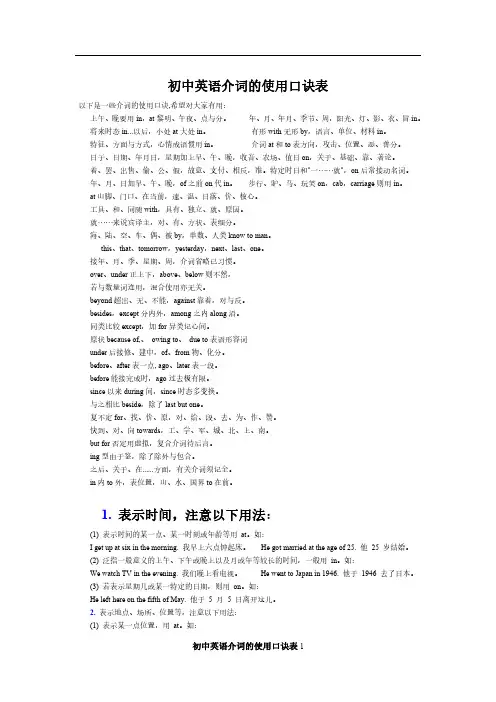
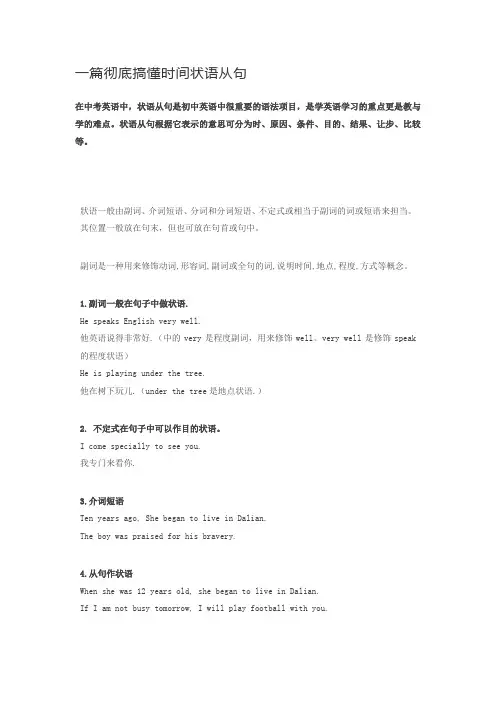
一篇彻底搞懂时间状语从句在中考英语中,状语从句是初中英语中很重要的语法项目,是学英语学习的重点更是教与学的难点。
状语从句根据它表示的意思可分为时、原因、条件、目的、结果、让步、比较等。
狀语一般由副词、介词短语、分词和分词短语、不定式或相当于副词的词或短语来担当。
其位置一般放在句末,但也可放在句首或句中。
副词是一种用来修饰动词,形容词,副词或全句的词,说明时间,地点,程度,方式等概念。
1.副词一般在句子中做状语.He speaks English very well.他英语说得非常好.(中的very是程度副词,用来修饰well。
very well是修饰speak 的程度状语)He is playing under the tree.他在树下玩儿.(under the tree是地点状语.)2. 不定式在句子中可以作目的状语。
I come specially to see you.我专门来看你.3.介词短语Ten years ago, She began to live in Dalian.The boy was praised for his bravery.4.从句作状语When she was 12 years old, she began to live in Dalian.If I am not busy tomorrow, I will play football with you.5.分词作状语Having had a quarrel with his wife, he left home in a bad temper.Inhibited in one direction, it now seems that the Mississippi is about to take another.中考主要考查引导状语从句的连词、从句时态等方面。
重点考查时间状语从句、条件状语从句、结果状语从句和比较状语从句。
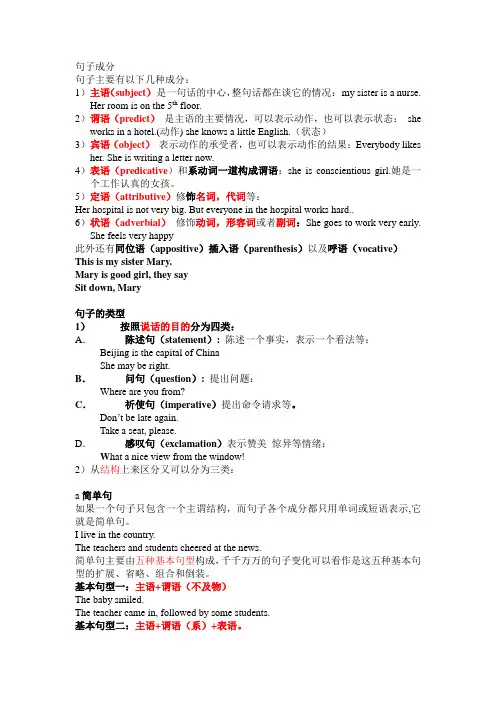
句子成分句子主要有以下几种成分:1)主语(subject)是一句话的中心,整句话都在谈它的情况:my sister is a nurse.Her room is on the 5th floor.2)谓语(predict)是主语的主要情况,可以表示动作,也可以表示状态:she works in a hotel.(动作) she knows a little English.(状态)3)宾语(object)表示动作的承受者,也可以表示动作的结果:Everybody likes her. She is writing a letter now.4)表语(predicative)和系动词一道构成谓语:she is conscientious girl.她是一个工作认真的女孩。
5)定语(attributive)修饰名词,代词等:Her hospital is not very big. But everyone in the hospital works hard..6)状语(adverbial)修饰动词,形容词或者副词:She goes to work very early.She feels very happy此外还有同位语(appositive)插入语(parenthesis)以及呼语(vocative)This is my sister Mary.Mary is good girl, they saySit down, Mary句子的类型1)按照说话的目的分为四类:A.陈述句(statement): 陈述一个事实,表示一个看法等:Beijing is the capital of ChinaShe may be right.B.问句(question): 提出问题:Where are you from?C.祈使句(imperative)提出命令请求等。
Don’t be late again.Take a seat, please.D.感叹句(exclamation)表示赞美惊异等情绪:W hat a nice view from the window!2)从结构上来区分又可以分为三类:a简单句如果一个句子只包含一个主谓结构,而句子各个成分都只用单词或短语表示,它就是简单句。
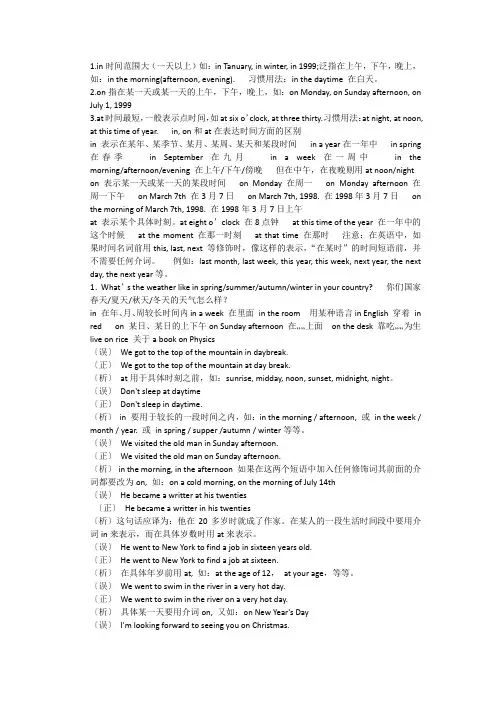
1.in时间范围大(一天以上)如:in Tanuary, in winter, in 1999;泛指在上午,下午,晚上,如:in the morning(afternoon, evening). 习惯用法:in the daytime 在白天。
2.on指在某一天或某一天的上午,下午,晚上,如:on Monday, on Sunday afternoon, on July 1, 19993.at时间最短,一般表示点时间,如at six o’clock, at three thirty.习惯用法:at night, at noon, at this time of year. in, on和at在表达时间方面的区别in 表示在某年、某季节、某月、某周、某天和某段时间in a year在一年中in spring 在春季in September 在九月in a week 在一周中in the morning/afternoon/evening 在上午/下午/傍晚但在中午,在夜晚则用at noon/night on 表示某一天或某一天的某段时间on Monday 在周一on Monday afternoon 在周一下午on March 7th 在3月7日on March 7th, 1998. 在1998年3月7日on the morning of March 7th, 1998. 在1998年3月7日上午at 表示某个具体时刻。
at eight o’clock 在8点钟at this time of the year 在一年中的这个时候at the moment 在那一时刻at that time 在那时注意:在英语中,如果时间名词前用this, last, next 等修饰时,像这样的表示,“在某时”的时间短语前,并不需要任何介词。
例如:last month, last week, this year, this week, next year, the next day, the next year等。
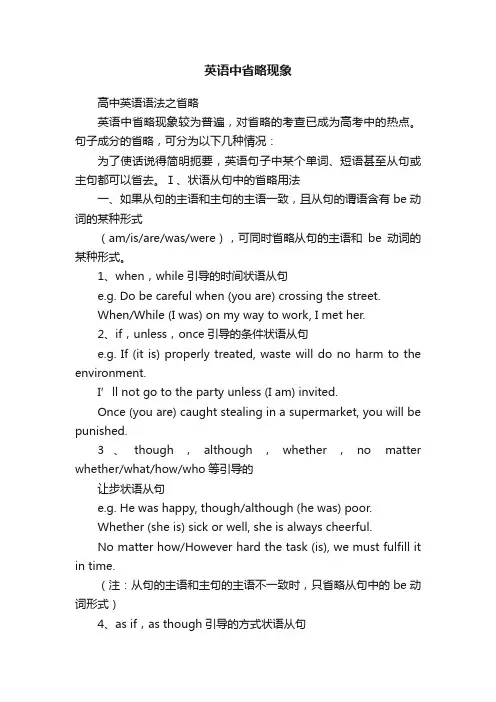
英语中省略现象高中英语语法之省略英语中省略现象较为普遍,对省略的考查已成为高考中的热点。
句子成分的省略,可分为以下几种情况:为了使话说得简明扼要,英语句子中某个单词、短语甚至从句或主句都可以省去。
Ⅰ、状语从句中的省略用法一、如果从句的主语和主句的主语一致,且从句的谓语含有be动词的某种形式(am/is/are/was/were),可同时省略从句的主语和be动词的某种形式。
1、when,while引导的时间状语从句e.g. Do be careful when (you are) crossing the street.When/While (I was) on my way to work, I met her.2、if,unless,once引导的条件状语从句e.g. If (it is) properly treated, waste will do no harm to the environment.I’ll not go to the party unless (I am) invited.Once (you are) caught stealing in a supermarket, you will be punished.3、though,although,whether,no matter whether/what/how/who等引导的让步状语从句e.g. He was happy, though/although (he was) poor.Whether (she is) sick or well, she is always cheerful.No matter how/However hard the task (is), we must fulfill it in time.(注:从句的主语和主句的主语不一致时,只省略从句中的be动词形式)4、as if,as though引导的方式状语从句e.g. He rubbed his eyes and yawned as if/though (he was) waking up after along sleep.He stood up as if/though (he wanted) to leave.(as if/though + to do表示一个将来的动作)二、than,as引导的比较状语从句中的省略用法:当不同的主语进行比较时,一般省略从句中的谓语;当从句中的主语与谓语(be动词除外)和主句中的主语与谓语相同时,通常省略从句中的主语和谓语,只保留比较部分。
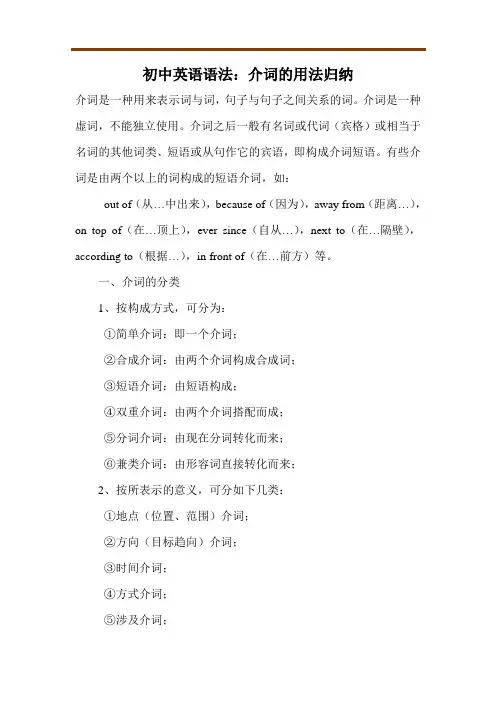
初中英语语法:介词的用法归纳介词是一种用来表示词与词,句子与句子之间关系的词。
介词是一种虚词,不能独立使用。
介词之后一般有名词或代词(宾格)或相当于名词的其他词类、短语或从句作它的宾语,即构成介词短语。
有些介词是由两个以上的词构成的短语介词,如:out of(从…中出来),because of(因为),away from(距离…),on top of(在…顶上),ever since(自从…),next to(在…隔壁),according to(根据…),in front of(在…前方)等。
一、介词的分类1、按构成方式,可分为:①简单介词:即一个介词;②合成介词:由两个介词构成合成词;③短语介词:由短语构成;④双重介词:由两个介词搭配而成;⑤分词介词:由现在分词转化而来;⑥兼类介词:由形容词直接转化而来;2、按所表示的意义,可分如下几类:①地点(位置、范围)介词;②方向(目标趋向)介词;③时间介词;④方式介词;⑤涉及介词;⑥其它介词:目的介词,原因介词,比较介词,伴随/状态介词。
二、介词短语的句法作用介词与其宾语一起构成的短语叫做介词短语,可在句子中充当一定成分,通常用作状语、定语和表语和宾语补足语。
如:The man camedown the stairs。
(状)(那个人走下楼来)The womanwith a flower on her headisfrom the countryside.(定)(头上戴花的妇女来自乡下)The teacher is nowwith the pupils.(表)(老师现在和学生在一起)When she woke up,she found herselfin hospital.(宾补)当她醒来时,发现自己已经在医院里。
三、介词短语在句子中的位置介词短语做状语时,如果表示时间/地点,可以放在句首或句尾。
如果表示方向/方式/伴随/涉及/原因/目的/比较,一般放在句尾;介词短语作表语时放在连系动词之后;介词短语作定语时,只能放在被修饰的名词之后。
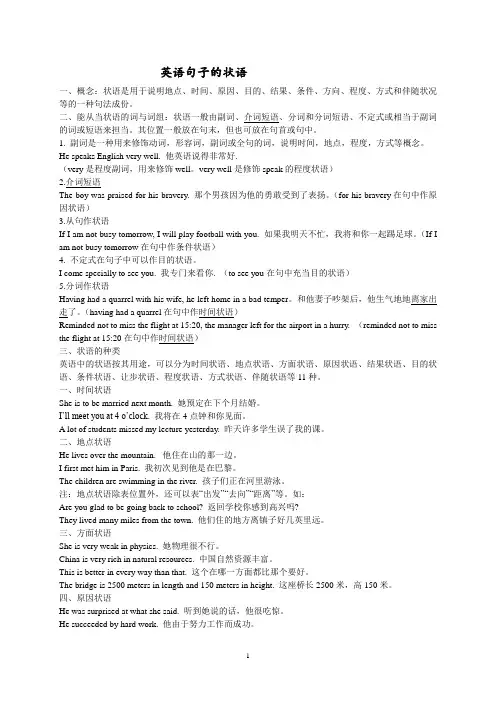
英语句子的状语一、概念:状语是用于说明地点、时间、原因、目的、结果、条件、方向、程度、方式和伴随状况等的一种句法成份。
二、能从当状语的词与词组:状语一般由副词、介词短语、分词和分词短语、不定式或相当于副词的词或短语来担当。
其位置一般放在句末,但也可放在句首或句中。
1. 副词是一种用来修饰动词,形容词,副词或全句的词,说明时间,地点,程度,方式等概念。
He speaks English very well. 他英语说得非常好.(very是程度副词,用来修饰well。
very well是修饰speak的程度状语)2.介词短语The boy was praised for his bravery. 那个男孩因为他的勇敢受到了表扬。
(for his bravery在句中作原因状语)3.从句作状语If I am not busy tomorrow, I will play football with you. 如果我明天不忙,我将和你一起踢足球。
(If I am not busy tomorrow在句中作条件状语)4. 不定式在句子中可以作目的状语。
I come specially to see you. 我专门来看你. (to see you在句中充当目的状语)5.分词作状语Having had a quarrel with his wife, he left home in a bad temper。
和他妻子吵架后,他生气地地离家出走了。
(having had a quarrel在句中作时间状语)Reminded not to miss the flight at 15:20, the manager left for the airport in a hurry. (reminded not to miss the flight at 15:20在句中作时间状语)三、状语的种类英语中的状语按其用途,可以分为时间状语、地点状语、方面状语、原因状语、结果状语、目的状语、条件状语、让步状语、程度状语、方式状语、伴随状语等11种。
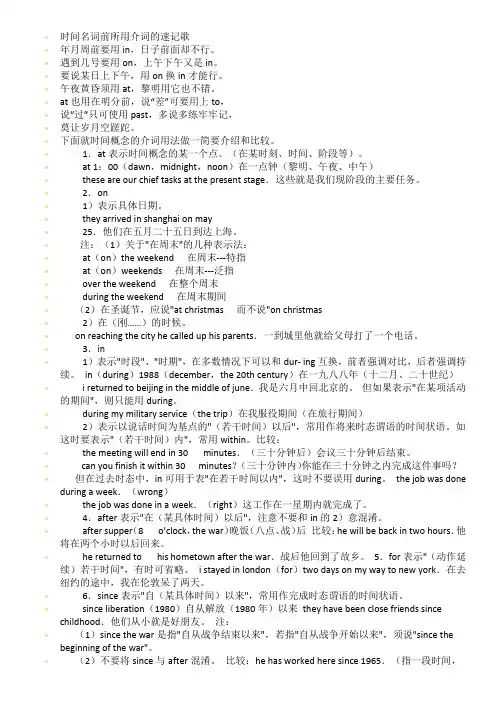
∙时间名词前所用介词的速记歌∙年月周前要用in,日子前面却不行。
∙遇到几号要用on,上午下午又是in。
∙要说某日上下午,用on换in才能行。
∙午夜黄昏须用at,黎明用它也不错。
∙at也用在明分前,说“差”可要用上to,∙说“过”只可使用past,多说多练牢牢记,∙莫让岁月空蹉跎。
∙下面就时间概念的介词用法做一简要介绍和比较。
∙1.at表示时间概念的某一个点。
(在某时刻、时间、阶段等)。
∙at 1:00(dawn,midnight,noon)在一点钟(黎明、午夜、中午)∙these are our chief tasks at the present stage.这些就是我们现阶段的主要任务。
∙2.on∙1)表示具体日期。
∙they arrived in shanghai on may∙25.他们在五月二十五日到达上海。
∙1)关于"在周末"的几种表示法:∙at(on)the weekend---特指∙at(on)weekends---泛指∙over the weekend∙during the weekend∙(2)在圣诞节,应说"at christmas"on christmas∙2)在(刚……)的时候。
∙on reaching the city he called up his parents.一到城里他就给父母打了一个电话。
∙3.in∙1)表示"时段"、"时期",在多数情况下可以和dur- ing互换,前者强调对比,后者强调持续。
in(during)1988(december,the 20th century)在一九八八年(十二月、二十世纪)∙i returned to beijing in the middle of june.我是六月中回北京的。
但如果表示"在某项活动的期间",则只能用during。
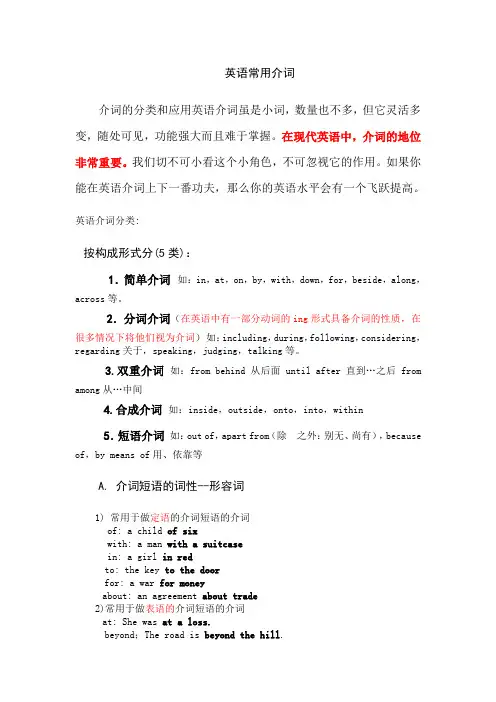
英语常用介词介词的分类和应用英语介词虽是小词,数量也不多,但它灵活多变,随处可见,功能强大而且难于掌握。
在现代英语中,介词的地位非常重要。
我们切不可小看这个小角色,不可忽视它的作用。
如果你能在英语介词上下一番功夫,那么你的英语水平会有一个飞跃提高。
英语介词分类:按构成形式分(5类):1.简单介词如:in,at,on,by,with,down,for,beside,along,across等。
2.分词介词(在英语中有一部分动词的ing形式具备介词的性质,在很多情况下将他们视为介词)如:including,during,following,considering,regarding关于,speaking,judging,talking等。
3.双重介词如:from behind从后面 until after直到…之后from among从…中间4.合成介词如:inside,outside,onto,into,within5.短语介词如:out of,apart from(除之外:别无、尚有),because of,by means of用、依靠等A. 介词短语的词性--形容词1) 常用于做定语的介词短语的介词of: a child of sixwith: a man with a suitcasein: a girl in redto: the key to the doorfor: a war for moneyabout: an agreement about trade2)常用于做表语的介词短语的介词at: She was at a loss.beyond;The road is beyond the hill.in: He’s still in danger.of: It’s of no value.on: He is on guard.值班out of: I’m out of job.under: He’s under forty.3) 用于做宾语补足语:I saw George at work.A cold kept him in bed for 7 days.B. 介词短语的词性—副词1)做状语,主要用于修饰谓语:He has been here since Monday.Bake it is for two hours.2) 用于be+adj.结构:She is afraid of snakes.I’m sorry about that.3) 修饰非谓语动词:I asked to speak to the headmaster.介词--短语动词中的关键角色含有介词的短语动词1. v.+ prep :agree with/to/on/in, answer for, ask for, come across, go after, live on, run into, head for, look for/after/at 等。
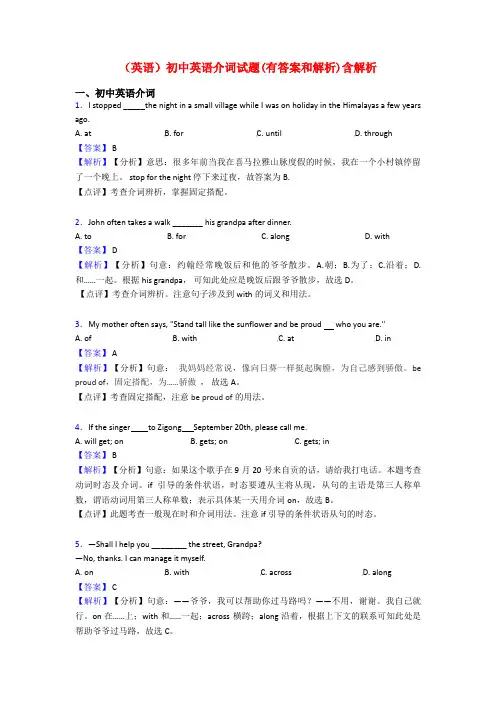
(英语)初中英语介词试题(有答案和解析)含解析一、初中英语介词1.I stopped _____the night in a small village while I was on holiday in the Himalayas a few years ago.A. atB. forC. untilD. through【答案】 B【解析】【分析】意思:很多年前当我在喜马拉雅山脉度假的时候,我在一个小村镇停留了一个晚上。
stop for the night停下来过夜,故答案为B.【点评】考查介词辨析,掌握固定搭配。
2.John often takes a walk _______ his grandpa after dinner.A. toB. forC. alongD. with【答案】 D【解析】【分析】句意:约翰经常晚饭后和他的爷爷散步。
A.朝;B.为了;C.沿着;D.和……一起。
根据his grandpa,可知此处应是晚饭后跟爷爷散步,故选D。
【点评】考查介词辨析。
注意句子涉及到with的词义和用法。
3.My mother often says, "Stand tall like the sunflower and be proud who you are." A. of B. with C. at D. in【答案】 A【解析】【分析】句意:我妈妈经常说,像向日葵一样挺起胸膛,为自己感到骄傲。
be proud of,固定搭配,为……骄傲,故选A。
【点评】考查固定搭配,注意be proud of的用法。
4.If the singer to Zigong September 20th, please call me.A. will get; onB. gets; onC. gets; in【答案】 B【解析】【分析】句意:如果这个歌手在9月20号来自贡的话,请给我打电话。

青春岁月介词的用法灵活多变,有些介词的词义相近容易造成混淆,如何正确使用这些介词成了困扰学生英语学习的头号难题,本文将对常用易混介词的用法及区别进行详细阐述。
一、概念介词是一种用来表示词与词,词与句之间的关系的词。
在句中不能单独作句字成分。
介词后面一般有名词代词或相当于名词的其他词类,短语或从句作它的宾语。
介词和它的宾语构成介词词组,在句中作状语、表语、补语或介词宾语。
二、时间介词的用法辨析1、时间介词in、on、at、by的用法辨析A.介词in用来表示一天中某段时间(早、午、晚),指年、月、季节、周次等。
如:in the mo rning,in spring,in the first week,in the Christmas ho liday s,in the eighteenth century,in ancient times.B.介词on用来表示某一天(日子、日期、年月日)或星期几,星期加上早午晚等。
如:on the secon d o f January/on Januaryth e second,o n February the thirteenth l893,o n a summer evening,on New Year’s Day,on my birthday,on winter day,on Sunday,on Saturday afternoo n,o n the mo rning o f18th.On the eve o f their departure they g av e a farewell banquet.他们在临行前夕举行了一次告别宴会。
C.介词at用来表示黎明、午、夜、点与分,节日、年龄等,如:at no on,at night,at dawn,at6:20(以上短语都不用冠词),at the present day。
D.介词by表示“……的时候”、“到”、“等到……已”等用在天、时间的前面。
英语名词作状语的结构及其用法在英语句子中,状语通常由副词或介词短语来充当。
名词主要用作主语、宾语和表语等句子成分,其作状语直接修饰动词、副词、形容词等的用法经常被忽略。
其实在英语的实际使用中,名词作状语很普遍。
尤其是在现代英语口语中,名词作状语这一现象屡见不鲜。
而一般语法书对此谈得很少,甚至只字未提。
笔者在此就英语名词作状语的结构及其用法作一粗浅归纳,以期对英语学习者有所帮助。
一、名词作状语的结构1.名词+s该结构中的名词主要是表示“时间”意义的名词,加上s后在句中作状语,有些词典因而把这类名词看作副词。
如:hours, mornings, afternoons, evenings, nights, weekends, Mondays, Tuesdays等。
这类名词主要用于美国英语。
例如: We have been sitting here hours waiting for you.We worked nights at that time.Tuesdays I usually go to the library to read some magazines.I haven' t so much to do evenings and weekends.2.不定冠词+名词该结构有时表达程度轻、数量少、时间短。
例如:I hardly slept a wink last night.昨天晚上我连眼都没合。
Wait a minute, please!3.不定代词+名词不定代词some, any, all, another等加上一些表时间意义或行为方法的名词,通常在句中直接作状语。
例如:He has waited some time.I will stay another five months.It may start raining any moment.Do it any way you like.4.指示代词+名词该结构构成的名词短语通常在句中充当状语。
中考英语专题复习之介词【知识梳理】一、考查简单介词的用法[知识链接]分类例词in,at,on,between,since,for,during,until,till,by,from,表示时间to,by,before,pastin,at,on,around,before,in front of,between,behind,表示方位beside,near,under,above,below,,next to,among表示往返的方向其他to,towards,round,around,though,across,f rom…to, into,out of,off,alongby,to,like,unlike,of,except,about,against,with,but, as,without(一)时间介词1.at、in、on表示时间的区别(1)at表示具体的时间点,常用于表示钟点及某些词组中。
如:at Christmas(在圣诞节);at night(在晚上);at six o’cl ock(在6点钟);at the end of(在……结束时);at the age of(在……岁时);at last(最终,最后)。
(2)in还可以表示从现在算起到若干时间以后,意为“在……时间后”,用于一般将来时或过去将来时态。
如:Can you finish drawing a good horse in five minutes?你能在5分钟内画一匹好看的马吗?(3)on用于表示确定的时间,具体某一天或具体某一天的上午、下午、晚上或一般节日等。
如:on December1st,1994(在1994年12月1日);on Teachers’Day(在教师节)on Monday morning(在星期一上午);on a cold morning(在一个寒冷的早晨);on the night of October22nd(在10月22日晚上);on Christmas Day(在圣诞节)。
2019年高考英语语法必考考点(4)介词(含解析)编辑整理:尊敬的读者朋友们:这里是精品文档编辑中心,本文档内容是由我和我的同事精心编辑整理后发布的,发布之前我们对文中内容进行仔细校对,但是难免会有疏漏的地方,但是任然希望(2019年高考英语语法必考考点(4)介词(含解析))的内容能够给您的工作和学习带来便利。
同时也真诚的希望收到您的建议和反馈,这将是我们进步的源泉,前进的动力。
本文可编辑可修改,如果觉得对您有帮助请收藏以便随时查阅,最后祝您生活愉快业绩进步,以下为2019年高考英语语法必考考点(4)介词(含解析)的全部内容。
2019年高考英语语法必考考点(4):介词含解析李仕才【考点解读】介词无法在句中独立担当成分,其后一般接名词、代词或动词-ing形式,还可接不定式(如:except, but)或that引导的从句作宾语,构成介词短语,有时还可接另外一个介词短语(如:from among the trees)。
一、介词的分类:1。
从结构上分,可分为:简单介词(如:at, in, on, for, over,up)、合成介词(如:inside, outside, within, without)、以-ing结尾的介词(如:concerning, including, excluding, following)和短语介词(如:according to, because of, apart from, in case of)。
2。
从含义上分,可分为表示时间(如:at, in, on, before, between)、地点(如:at, in, on, under, behind)、趋向(如:to / towards, across, off, up)、原因(如:for, with, due to)、让步(如:despite, in spite of)和条件(如:in case of, without, but for)等的介词。
英语介词专项训练及答案及解析一、初中英语介词1.Don't stay inside such a sunny morning. Let's go out to enjoy the gentle wind and the sweet flowers.A. onB. inC. fromD. at【答案】A【解析】【分析】句意:不要在这样一个阳光明媚的早晨呆在家里。
让我们一起去享受温柔的风和甜蜜的花朵。
A. on 用在某一天,或某一天的早晨,下午、晚上的前面;B. in用在某年,某月,或季节的前面;C. from从,来自;D. at用在表示点钟的时刻前面。
此句中的morning前有形容词sunny来修饰,特指这样的一个上午,前面要用介词on,故选A。
【点评】考查介词辨析。
熟记不同的时间前面的介词用法。
2.Let's take a walk ________ the river after diner, shall we?A. alongB. throughC. uponD. over【答案】 A【解析】【分析】句意:让我们晚饭后沿着河流散步吧,好吗?A.沿着;B.穿过;C.根据;D.在......正上方。
根据常识可知沿着河流散步,along the river,沿着河流,固定搭配,故选A。
【点评】考查介词辨析,注意平时识记其词义,理解句意。
3.I will go around the city of Dalian by light-rail vehicle(轻轨) subway because I haven't taken it before.A. instead ofB. in the face ofC. along withD. across from【答案】 A【解析】【分析】句意:我打算不坐地铁,坐轻轨车参观大连,因为我以前从没有坐过。
A.而不是;B.面对;C.和……一起;D.在……对面。
By,before,until三个介词的用法区别一、until与by的区别1. by表示在某特定的时间之前或不迟于某特定的时间,意为"最迟在;不迟于"或"在……之前"等。
如:①I will finish my task by nine.我将在九点钟前完成任务。
②The plane takes off at 10:00, so you must try to be at the airport by 9:30.飞机在十点钟起飞,所以你必须在九点半赶到机场。
2. until用在肯定句,谓语动词通常是延续性动词,如stand, stay, talk, wait等,表示主句动作终止的时间。
如:③I waited until he came back.我一直等到他回来。
④The war lasted until 1945.战争持续到1945年。
如果用在否定句,谓语动词通常是瞬间性动词,如open, start, leave, arrive, finish, stop等,强调主句动作开始的时间。
如:⑤I didn't leave the boy until his mother turned up.直到这孩子的母亲来,我才离开。
⑥The noise of the street didn't stop until it was midnight.街上的噪音直到半夜才停止。
二、until与before的区别1.可直接换用的情况:在until能使用的句型中,即主句含有否定式终止性谓语动词或肯定式延续性动词,可与before直接替换,意义差别不大。
如:①The students won't go home until / before they finish their homework.学生们要先完成作业才能回家。
②The woman worked in the factory until/before 1990. 1990年以前这妇女在这家工厂上班。
英语时间状语前不用介词的几种情况
一、当时间状语是today, yesterday, tomorrow, tonight, yesterday/tomorrow
morning(afternoon, evening)等时,其前不用介词。
例如:
There was a football match yesterday evening.昨天晚上有一场足球赛。
They will go to the zoo tomorrow.明天他们将要去动物园。
二、由this, that, these, those等构成的短语前不用介词。
例如:
I'll visit my grandparents this week.这一周我要去看望我的祖父母。
They are picking apples on the farm these days.这些天他们在农场摘苹果。
三、由形容词last,next等指示代词修饰的名词词组用作时间状语时,前面的介词at, on, in一般省略。
例如:
I saw him in the street sometime last week.上周我在街上见过他。
Please come to school earlier next time.下次请早点来学校。
但是,如果不是介词at, on, in,而是其他类型的介词,一般不能省略。
如:I haven't been to my hometown since last year.从去年以来我就没回过家乡。
*(四、在以“the day (week, month, year)+before/after…”构成的时间状语前不用介词。
例如:Where did you go the day before yesterday? 前天你去哪里了?
They'll have a party the day after tomorrow.他们后天将举行一个聚会。
五、由every, each等表示频率的副词构成的短语用做时间状语时,其前不用介词。
例如:
Do you watch TV every day? 你们每天看电视吗?
They go to school by bike each day.他们每天骑自行车去上学。
)*
六、由on引出的特定日子,可以省略介词on。
例如:
I can see him (on) New Year’s Day.在元旦我可以看见他。
七、for通常引出一段时间,当与表示静态的动词连用时可以省略。
例如:I have stayed there (for) three hours.我在那里已经呆了三个小时。
注意:1.当与动态动词连用,或在句首及否定句中,介词for不能省略。
如:I haven't heard from him for three years.我三年没有收到他的信了。
2.当walk, run, drive, travel等动词连用表示距离时,for可以省略。
如:
He ran (for) a mile in four minutes.他四分钟跑了一英里
八、以all构成的短语做时间状语,如all day, all the week, all the year等前面通常不用介词。
例如:
My mother was busy all day yesterday.昨天妈妈忙了一整天。
The girl was ill in bed all the week.这个女孩生病了,卧床整整一周。
注意:以all开头的短语前,介词通常省略。
如:
I haven't seen her all day.我整整一天没有看见他了。
九、当at about…表示时间时,介词at可以省略。
例如:
The sun rose (at) about six o'clock today.今天太阳大约在六点升起。